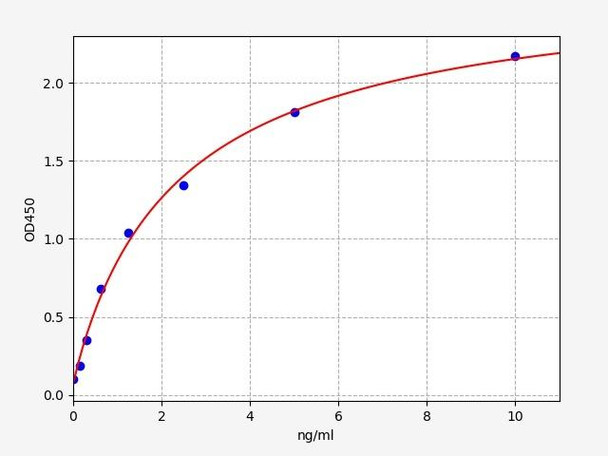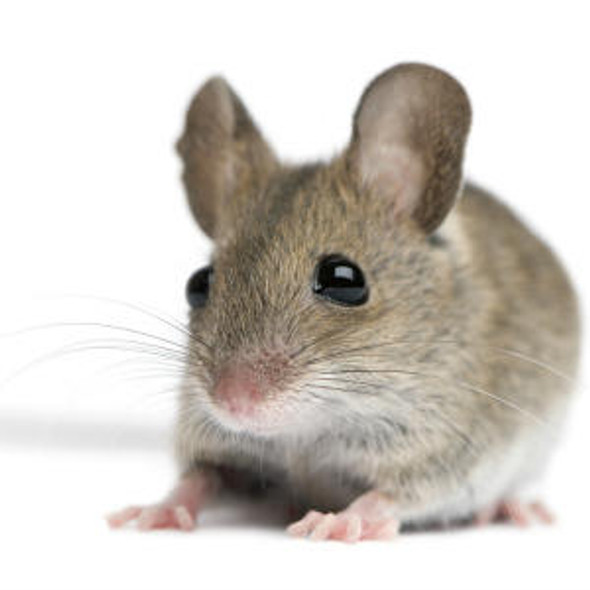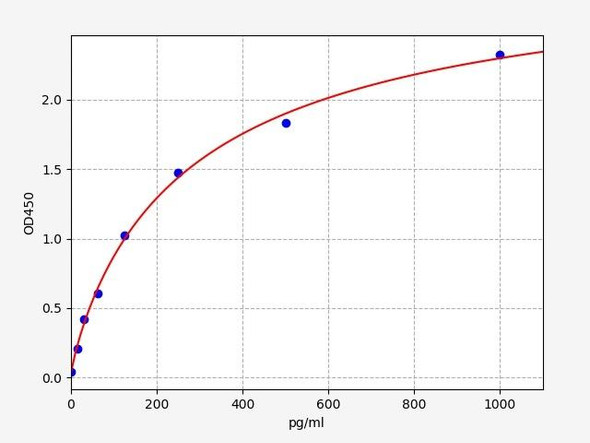Rat MTOR(Serine/threonine-protein kinase Mtor) ELISA Kit
- SKU:
- RTFI01278
- Product Type:
- ELISA Kit
- Size:
- 96 Assays
- Uniprot:
- P42346
- Sensitivity:
- 0.094ng/ml
- Range:
- 0.156-10ng/ml
- ELISA Type:
- Sandwich ELISA, Double Antibody
- Synonyms:
- MTOR, Serine, threonine-protein kinase mTOR, Rapamycin target protein 1, Rapamycin target protein 1, RAPT1, Mechanistic target of rapamycin, Mammalian target of rapamycin, mTOR, FK506-binding protein 12-rapamycin complex-associated protein 1, FKBP12-
- Reactivity:
- Rat
Description
| Product Name: | Rat MTOR (Serine/threonine-protein kinase Mtor) ELISA Kit |
| Product Code: | RTFI01278 |
| Size: | 96 Assays |
| Target: | Rat MTOR |
| Alias: | MTOR, Serine, threonine-protein kinase mTOR, Rapamycin target protein 1, Rapamycin target protein 1, RAPT1, Mechanistic target of rapamycin, Mammalian target of rapamycin, mTOR, FK506-binding protein 12-rapamycin complex-associated protein 1, FKBP12-rapamycin complex-associated protein, FRAP, FRAP1, FRAP2 |
| Reactivity: | Rat |
| Detection Method: | Sandwich ELISA, Double Antibody |
| Sensitivity: | 0.094ng/ml |
| Range: | 0.156-10ng/ml |
| Storage: | 4°C for 6 months |
| Note: | For Research Use Only |
| Recovery: | Matrices listed below were spiked with certain level of Rat MTOR and the recovery rates were calculated by comparing the measured value to the expected amount of Rat MTOR in samples. Please contact us for more information. |
| Linearity: | The linearity of the kit was assayed by testing samples spiked with appropriate concentration of Rat MTOR and their serial dilutions. The results were demonstrated by the percentage of calculated concentration to the expected. Please get in contact for more information. |
| Intra-Assay: | CV <8% |
| Inter-Assay: | CV <10% |
| Uniprot: | P42346 |
| UniProt Protein Function: | mTOR: an atypical kinase belonging to the PIKK family of kinases. Is the catalytic subunit of two protein complexes, mTORC1 and mTORC2. mTORC1 activates S6K and inactivates 4E-BP1, up-regulating protein synthesis. mTORC1 contains Raptor, a positive regulatory subunit and scaffold for recruiting substrates, two negative regulators, PRAS40 and DEPTOR, and mLST8; it is a target for the cell-cycle arrest and immunosuppressive effects of the FKBP12-rapamycin complex. mTORC2, a downstream effector of PI3K, is insensitive to rapamycin and activates Akt by phosphorylating a key activation site. mTORC2 contains regulatory subunits Rictor and mSIN1, PROTOR, mLST8, and the negative regulator DEPTOR. mTORC1 suppresses PI3K activity via a strong negative feedback loop that involves S6K1. Inhibiting mTORC1 ablates this negative feedback loop and potentiates PI3K signaling. Known inhibitors of mTOR include rapamycin, temsirolimus (CCI-779). |
| UniProt Protein Details: | Protein type:ATYPICAL group; Autophagy; EC 2.7.11.1; FRAP subfamily; Kinase, protein; Motility/polarity/chemotaxis; PIKK family; Protein kinase, Ser/Thr (non-receptor); Protein kinase, atypical Chromosomal Location of Human Ortholog: 5q36 Cellular Component: cell soma; cytoplasm; cytosol; dendrite; endomembrane system; lysosomal membrane; lysosome; membrane; nucleus; PML body; TORC2 complex Molecular Function:kinase activity; phosphoprotein binding; protein binding; protein domain specific binding; protein kinase activity; protein kinase binding; protein serine/threonine kinase activity; ribosome binding Biological Process: 'de novo' pyrimidine base biosynthetic process; brain development; cardiac cell development; cardiac muscle cell development; cardiac muscle contraction; cardiac muscle development; cell aging; cell growth; cell projection organization and biogenesis; cellular response to amino acid starvation; cellular response to nutrient levels; energy reserve metabolic process; germ cell development; heart morphogenesis; long-term memory; maternal process involved in pregnancy; mRNA stabilization; multicellular organism growth; negative regulation of autophagy; negative regulation of cell size; negative regulation of macroautophagy; negative regulation of muscle atrophy; negative regulation of NFAT protein import into nucleus; negative regulation of protein amino acid phosphorylation; negative regulation of protein ubiquitination; peptidyl-serine phosphorylation; peptidyl-threonine phosphorylation; phosphorylation; positive regulation of actin filament polymerization; positive regulation of endothelial cell proliferation; positive regulation of keratinocyte migration; positive regulation of lipid biosynthetic process; positive regulation of neurogenesis; positive regulation of neuron maturation; positive regulation of nitric oxide biosynthetic process; positive regulation of oligodendrocyte differentiation; positive regulation of peptidyl-tyrosine phosphorylation; positive regulation of protein amino acid phosphorylation; positive regulation of protein kinase B signaling cascade; positive regulation of smooth muscle cell proliferation; positive regulation of stress fiber formation; positive regulation of transcription from RNA polymerase III promoter; positive regulation of translation; post-embryonic development; protein amino acid autophosphorylation; protein amino acid phosphorylation; regulation of actin cytoskeleton organization and biogenesis; regulation of carbohydrate metabolic process; regulation of carbohydrate utilization; regulation of cell size; regulation of fatty acid beta-oxidation; regulation of glycogen biosynthetic process; regulation of GTPase activity; regulation of myelination; regulation of osteoclast differentiation; regulation of protein amino acid phosphorylation; regulation of protein kinase activity; regulation of protein kinase B signaling cascade; regulation of response to food; response to amino acid stimulus; response to cocaine; response to insulin stimulus; response to morphine; ruffle organization and biogenesis; social behavior; spinal cord development; TOR signaling pathway; visual learning; voluntary musculoskeletal movement; wound healing |
| NCBI Summary: | binds the complex formed by the immunosuppressive drug rapamycin and its receptor FKBP12; may play a role in the cell cycle G1 to S transition [RGD, Feb 2006] |
| UniProt Code: | P42346 |
| NCBI GenInfo Identifier: | 1169736 |
| NCBI Gene ID: | 56718 |
| NCBI Accession: | P42346.1 |
| UniProt Related Accession: | P42346 |
| Molecular Weight: | 288,794 Da |
| NCBI Full Name: | Serine/threonine-protein kinase mTOR |
| NCBI Synonym Full Names: | mechanistic target of rapamycin |
| NCBI Official Symbol: | Mtor |
| NCBI Official Synonym Symbols: | Frap1; RAFT1 |
| NCBI Protein Information: | serine/threonine-protein kinase mTOR |
| UniProt Protein Name: | Serine/threonine-protein kinase mTOR |
| UniProt Synonym Protein Names: | FK506-binding protein 12-rapamycin complex-associated protein 1; FKBP12-rapamycin complex-associated protein; Mammalian target of rapamycin; mTOR; Mechanistic target of rapamycin; Rapamycin target protein 1; RAPT1 |
| Protein Family: | Serine/threonine-protein kinase |
| UniProt Gene Name: | Mtor |
| Step | Procedure |
| 1. | Set standard, test sample and control (zero) wells on the pre-coated plate respectively, and then, record their positions. It is recommended to measure each standard and sample in duplicate. Wash plate 2 times before adding standard, sample and control (zero) wells! |
| 2. | Aliquot 0.1ml standard solutions into the standard wells. |
| 3. | Add 0.1 ml of Sample / Standard dilution buffer into the control (zero) well. |
| 4. | Add 0.1 ml of properly diluted sample ( Human serum, plasma, tissue homogenates and other biological fluids.) into test sample wells. |
| 5. | Seal the plate with a cover and incubate at 37°C for 90 min. |
| 6. | Remove the cover and discard the plate content, clap the plate on the absorbent filter papers or other absorbent material. Do NOT let the wells completely dry at any time. Wash plate X2. |
| 7. | Add 0.1 ml of Biotin- detection antibody working solution into the above wells (standard, test sample & zero wells). Add the solution at the bottom of each well without touching the side wall. |
| 8. | Seal the plate with a cover and incubate at 37°C for 60 min. |
| 9. | Remove the cover, and wash plate 3 times with Wash buffer. Let wash buffer rest in wells for 1 min between each wash. |
| 10. | Add 0.1 ml of SABC working solution into each well, cover the plate and incubate at 37°C for 30 min. |
| 11. | Remove the cover and wash plate 5 times with Wash buffer, and each time let the wash buffer stay in the wells for 1-2 min. |
| 12. | Add 90 µL of TMB substrate into each well, cover the plate and incubate at 37°C in dark within 10-20 min. (Note: This incubation time is for reference use only, the optimal time should be determined by end user.) And the shades of blue can be seen in the first 3-4 wells (with most concentrated standard solutions), the other wells show no obvious color. |
| 13. | Add 50 µL of Stop solution into each well and mix thoroughly. The color changes into yellow immediately. |
| 14. | Read the O.D. absorbance at 450 nm in a microplate reader immediately after adding the stop solution. |
When carrying out an ELISA assay it is important to prepare your samples in order to achieve the best possible results. Below we have a list of procedures for the preparation of samples for different sample types.
| Sample Type | Protocol |
| Serum: | If using serum separator tubes, allow samples to clot for 30 minutes at room temperature. Centrifuge for 10 minutes at 1,000x g. Collect the serum fraction and assay promptly or aliquot and store the samples at -80°C. Avoid multiple freeze-thaw cycles. If serum separator tubes are not being used, allow samples to clotovernight at 2-8°C. Centrifuge for 10 minutes at 1,000x g. Removeserum and assay promptly or aliquot and store the samples at-80°C. Avoid multiple freeze-thaw cycles. |
| Plasma: | Collect plasma using EDTA or heparin as an anti-coagulant. Centrifuge samples at 4°C for 15 mins at 1000 — g within 30 mins of collection. Collect the plasma fraction and assay promptly or aliquot and store the samples at -80°C. Avoid multiple freeze-thaw cycles.Note: Over haemolysed samples are not suitable for use with this kit. |
| Urine & Cerebrospinal Fluid: | Collect the urine (mid-stream) in a sterile container, centrifuge for 20 mins at 2000-3000 rpm. Remove supernatant and assay immediately. If any precipitation is detected, repeat the centrifugation step. A similar protocol can be used for cerebrospinal fluid. |
| Cell Culture Supernatant: | Collect the cell culture media by pipette, followed by centrifugation at 4°C for 20 mins at 1500 rpm. Collect the clear supernatant and assay immediately. |
| Cell Lysates: | Solubilize cells in lysis buffer and allow to sit on ice for 30 minutes. Centrifuge tubes at 14,000 x g for 5 minutes to remove insoluble material. Aliquot the supernatant into a new tube and discard the remaining whole cell extract. Quantify total protein concentration using a total protein assay. Assay immediately or aliquot and store at ≤ -20°C. |
| Tissue Homogenates: | The preparation of tissue homogenates will vary depending upon tissue type. Rinse tissue with 1X PBS to remove excess blood & homogenizein 20ml of 1X PBS (including protease inhibitors) and store overnight at ≤ -20°C. Two freeze-thaw cycles are required to break the cell membranes. To further disrupt the cell membranes you can sonicate the samples. Centrifuge homogenates for 5 mins at 5000xg. Remove the supernatant and assay immediately or aliquot and store at -20°C or-80°C. |
| Tissue Lysates: | Rinse tissue with PBS, cut into 1-2 mm pieces, and homogenize with a tissue homogenizer in PBS. Add an equal volume of RIPA buffer containing protease inhibitors and lyse tissues at room temperature for 30 minutes with gentle agitation. Centrifuge to remove debris. Quantify total protein concentration using a total protein assay. Assay immediately or aliquot and store at ≤ -20 °C. |
| Breast Milk: | Collect milk samples and centrifuge at 10,000 x g for 60 min at 4°C. Aliquot the supernatant and assay. For long term use, store samples at -80°C. Minimize freeze/thaw cycles. |










